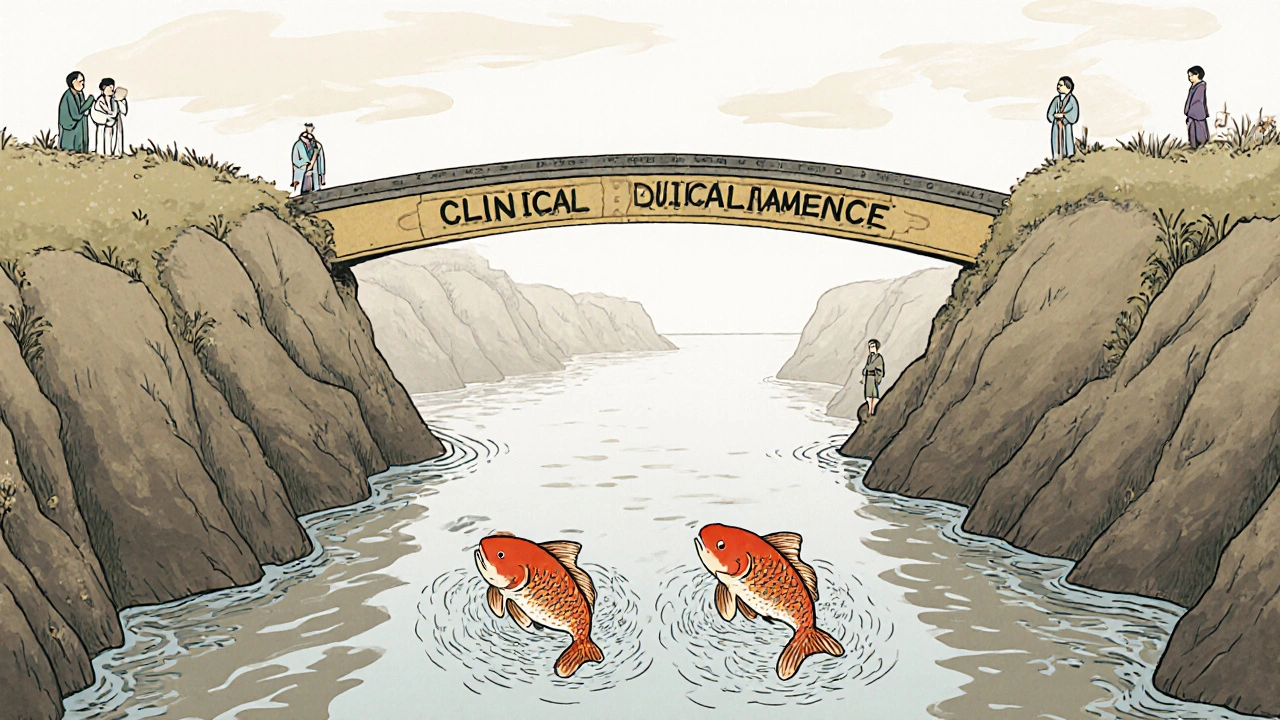When you switch from an originator biologic to a biosimilar, you’re not switching to a generic pill. This isn’t like changing from brand-name ibuprofen to a store brand. Biologics are made from living cells - complex proteins that behave like tiny machines in your body. Even small changes in how they’re made can affect how they work. That’s why biosimilars aren’t copies. They’re highly similar - but not identical.
Hva er en biosimilar?
A biosimilar is a biological medicine that works almost the same as an already-approved originator drug. It’s not a copy, because biologics can’t be exactly replicated like chemical pills. Think of it like two handmade sweaters from the same pattern. They look nearly the same, feel similar, and keep you warm the same way - but one might have a slightly different stitch or yarn blend. Regulatory agencies like the EMA and FDA require biosimilars to show no clinically meaningful differences in safety, purity, or potency. That means if you’re stable on the original drug, switching shouldn’t make you sicker or less well-controlled.
The first biosimilar approved in Europe was Omnitrope (somatropin) in 2006. In the U.S., Zarxio (filgrastim-sndz) followed in 2015. Today, over 37 biosimilars are approved in the U.S. alone, mostly targeting TNF inhibitors like infliximab and adalimumab - drugs used for rheumatoid arthritis, psoriasis, Crohn’s disease, and other chronic inflammatory conditions.
Hva skjer når du bytter?
Switching happens for two main reasons: cost and access. Originator biologics can cost $20,000-$30,000 per year. Biosimilars often launch at 15-35% lower prices. In 2023, Humira biosimilars entered the U.S. market at a 35% discount. Health systems use this savings to treat more patients. But patients often worry: Will I still feel the same?
Large studies show the answer is usually yes. The NOR-Switch trial in Norway followed 481 patients switching from originator infliximab to its biosimilar CT-P13. After one year, 52.6% stayed on the biosimilar. The original group had 60% retention. That difference wasn’t statistically significant. Similar results came from studies in Denmark, Spain, and the U.S. Retention rates - meaning patients who kept taking the drug without stopping - stayed above 85% in most real-world settings.
Even when patients switch between biosimilars - say, from CT-P13 to SB2 - data shows stability. A 2022 study of 140 patients switching twice (originator → CT-P13 → SB2) found immunogenicity rates of only 3 per 100 patient-years. Trough levels (the amount of drug in your blood between doses) stayed nearly unchanged: 4.3 μg/mL before switch, 4.1 μg/mL after. No new safety signals appeared.
Hvorfor stopper noen?
Not everyone stays on the new drug. Around 4-18% discontinue after a switch. But here’s the key: most of those drops aren’t because the drug stopped working. They’re because patients feel like it did.
This is called the nocebo effect - the opposite of placebo. If you’re told, “You’re getting a cheaper version,” your brain might start interpreting normal aches or fatigue as side effects. A 2021 study in Frontiers in Psychology found 32.7% of patients reported new symptoms after switching - even when lab tests showed no change in disease activity. Reddit threads from patients with rheumatoid arthritis are full of posts like: “I switched to the biosimilar and suddenly I can’t walk in the morning.” But when doctors checked their DAS28 scores - a standard measure of RA activity - everything was still in remission.
Actual drug failures are rare. Injection site reactions happen in about 7.8% of adalimumab biosimilar switches. Immunogenicity - your body making antibodies against the drug - occurs in under 2% of patients per year. That’s not higher than with the originator. In fact, the same immune response can happen whether you’re on the original or the biosimilar.

Hva sier forskere og myndigheter?
Regulatory agencies are clear. The EMA’s 2022 position paper says: “Switching between reference medicine and biosimilar or between biosimilars is not expected to compromise safety or efficacy.” The FDA reviewed 22 switching studies with over 5,700 patients and found no increase in serious adverse events, death, or discontinuation. Their conclusion? Switching is safe.
But not everyone agrees. Health Canada has warned that biologics “do not have fully defined and reproducible structures,” making true copies impossible. Dr. Kenneth Fass, an IBD specialist, points out that 20% of IBD patients lose response to infliximab each year - regardless of whether it’s the originator or biosimilar. So when a patient flares after switching, is it the drug? Or just the disease doing what it normally does?
Real-world data supports safety. In the DANBIO registry, 68% of patients reported no issues after switching infliximab to its biosimilar. In psoriasis, a Danish cohort study found 79% retention with biosimilars versus 81.3% with the originator - a negligible difference.
Hvordan gjør man et godt skifte?
Switching works best when it’s done right. Randomly changing your drug at the pharmacy without warning is a recipe for anxiety - and higher discontinuation. The PERFUSE study showed that when patients got proper education before switching, discontinuation dropped from 18% to just 6.4%.
Here’s what works:
- Pre-switch counseling - at least 20 minutes with your doctor. Explain what biosimilars are, why you’re switching, and what to expect.
- Shared decision-making - let patients ask questions. Don’t just inform - involve them.
- Post-switch monitoring - check disease activity at 3 months. Use DAS28 for arthritis, PASI for psoriasis, or fecal calprotectin for IBD.
- Track trough levels - if drug levels drop suddenly, it might signal immunogenicity.
Doctors need to be trained in biologic monitoring. Nurses should be ready to answer questions. Pharmacies should not automatically substitute unless the drug is officially designated as “interchangeable” - a status only granted by the FDA after specific switching studies.

Er biosimilarskifte trygt for alle?
No. Not everyone should switch.
Patients with highly active disease - DAS28 over 5.1 in RA, or active Crohn’s with high calprotectin - should stay on their current drug. Switching during flare-ups increases risk. Same for patients who’ve had multiple prior switches. A 2022 Spanish study found 15.3% discontinued after switching from one biosimilar to another in IBD patients - higher than in those switching only once.
Also avoid switching if you’ve had a serious reaction to the originator. While biosimilars are similar, they’re not identical. If you had an anaphylactic reaction, switching isn’t worth the risk.
But for most patients - stable, in remission, on a single biologic - switching is not just safe. It’s smart.
Hva er fremtiden?
Europe leads in biosimilar use. In Norway, 67% of filgrastim prescriptions are biosimilars. The U.S. lags behind at 24% for infliximab, mostly due to rebate deals and patent tricks. But that’s changing. In 2024, the FDA approved the first interchangeable adalimumab biosimilar - Cyltezo. That means pharmacies can swap it in without asking the doctor.
The NOR-SWITCH II study, extending past two years, shows 89.2% of patients still on treatment after multiple switches. That’s not just safe - it’s sustainable.
Cost savings are massive. The global biosimilar market hit $26.3 billion in 2022 and is growing at 21.5% per year. Over $178 billion in biologic patents are expiring by 2025. That means more biosimilars. More access. More patients treated.
Switching isn’t about cutting corners. It’s about using science to make care more fair. If a biosimilar keeps you in remission, saves the system money, and lets someone else get treatment - why wouldn’t you switch?
Just make sure it’s done right. With information. With trust. And with monitoring.

8 Comments
Kristine Scheufele
Ja selvfølgelig er biosimilars trygge - så lenge du ikke er en av de som faktisk blir sykere av detmen vi må spare penger fordi regjeringen er dårlig på å forvalte pengene sineog alle som sier nei er bare fryktige konservative som ikke forstår vitenskapenog jeg har lest hele EMA-dokumentet så jeg vet bedre enn din lege
Siri Nergaard
Det er fascinerende hvordan den postmoderne farmakøkonomien har rekonfigurert den terapeutiske subjektiviteten i et kapitalistisk regime hvor biologiske entiteter blir reduksjonistisk redefinert som kommodifiserte varianter av en ursprunnslig ideell formog samtidig er det en ironisk paradoks at vi krever identisk virkning av et produkt som per definisjon ikke kan være identiskog likevel forventer full sikkerhetog ingen immunogenisitetog ingen nocebo-effekterog ingen psykologisk diskontinuitet
Ronny Heggelund
noe som er 99.9% likt er ikke likt punktum det er som å si at to mennesker er like fordi begge har to øyne og en nese men hva med sjelen og den lille forskjellen i stemmen og hvordan de nikker når de er uenige og det er nettopp det som skjer med biosimilars det er ikke bare kjemien det er hele eksistensen av proteinet og hvis du ikke forstår det så er du ikke en riktig vitenskapsmann
Rune Johansen
Denne hele biosimilar-saken er en klassisk case av systemisk manipulasjon gjennom regulering og psykologisk krigføringog vi har ikke sett de virkelige dataeneog ingen har publisert de lange-termine studiene med >5 år follow-upog alle de positive resultatene kommer fra de samme farmasøytiske selskapene som selger både originator og biosimilarog sånn sett er det ikke en switch det er en kvalitetsreduksjon med et nytt navn
Kristin Frese
Jeg skifta til biosimilar for tre måneder siden og føler meg litt mer slapp nåog jeg vet ikke om det er jeg eller detog jeg har ikke sagt noe til lege fordi jeg ikke vil at de skal tenke jeg er vanskelig
Dag Melillo
Det viktigste med biosimilars er ikke om de er like men om vi som samfunn har lært å stole på hverandre igjenog når en pasient frykter at en billigere versjon ikke vil fungere så er det ikke farmakologien det handler om det handler om mistillit til systemetog når vi tar vare på det psykologiske rommet i helsevesenet så blir alle behandlinger mer effektiveog det er ikke bare om du får riktig dose av proteinet det er om du får riktig oppfølgingog riktig samtaleog riktig tidog riktig menneske som sitter ved siden av deg og sier jeg tror på deg
Joyline Mutai
Det er så lett å si at det bare er nocebo men hva hvis det ikke er det hva hvis du bare er en av de som faktisk reagerer og så blir du kalt for paranoid og ikke tror på vitenskapen men jeg har ikke noe mot biosimilars jeg har bare ikke lyst til å være en eksperiment
Silje Jensen
har du prøvd å snakke med pasienter før du skifter? jeg jobber med rheuma og mange sier de føler seg mer stressa etter skifte selv om alt er likt det er som om de tror de har blitt byttet ut med en annen personog vi må ta det sakte og forklare godt ikke bare sende en epost fra apoteket